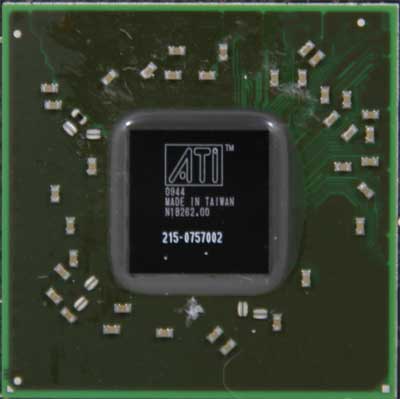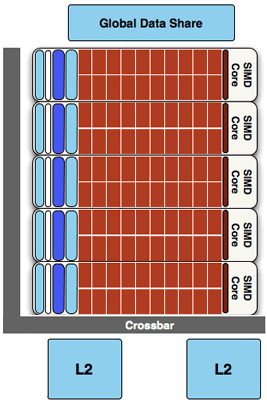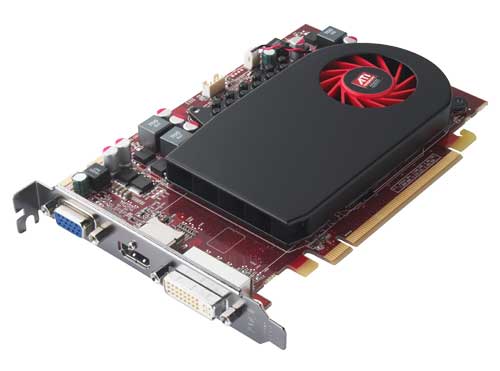AMD's Radeon HD 5670: Sub-$100 DirectX 11 Starts Today
by Ryan Smith on January 14, 2010 12:00 AM EST- Posted in
- GPUs
After a holiday break, AMD’s staggered launch of the Evergreen family picks back up today with the launch of the Radeon HD 5670. The 5670 marks the desktop launch of Redwood, the 3rd chip in the Evergreen family, designed to fit in below the Juniper chip that powers the Radeon HD 5700 series.
| ATI Radeon HD 5750 | ATI Radeon HD 4850 | ATI Radeon HD 4770 | ATI Radeon HD 5670 | ATI Radeon HD 4670 | |
| Stream Processors | 720 | 800 | 640 | 400 | 320 |
| Texture Units | 36 | 40 | 32 | 20 | 32 |
| ROPs | 16 | 16 | 16 | 8 | 8 |
| Core Clock | 700MHz | 625MHz | 750MHz | 775MHz | 750MHz |
| Memory Clock | 1.15GHz (4.6GHz data rate) GDDR5 | 993MHz (1986MHz data rate) GDDR3 | 800MHz (3200MHz data rate) GDDR5 | 1000MHz (4000MHz data rate) GDDR5 | 1000MHz (2000MHz data rate) GDDR3 |
| Memory Bus Width | 128-bit | 256-bit | 128-bit | 128-bit | 128-bit |
| Frame Buffer | 1GB / 512MB | 1GB / 512MB | 512MB | 1GB / 512MB | 1GB / 512MB |
| Transistor Count | 1.04B | 956M | 826M | 627M | 514M |
| TDP | 86W | 110W | 80W | 61W | 59W |
| Manufacturing Process | TSMC 40nm | TSMC 55nm | TSMC 40nm | TSMC 40nm | TSMC 55nm |
| Price Point | $129 - $149 | $99-$129 | $129 | $99 / $119 | $60-$90 |
AMD has been relatively straightforward in designing the Evergreen family. Each chip is half of its bigger brother. This means that the Redwood chip and the 5670 is in most ways half of a Juniper/5770: half the SIMDs (400), half the ROPs (8), half the texture units (20), etc. The core clocks are also slightly changed compared to the 5870 and 5770; here we have a core clock of 775MHz instead of 850MHz as found on those cards. So on paper, the 5670 is going to be slightly less than half of a 5770 in performance.
The one hardware unit that hasn’t been halved is the memory bus – we still have the same 128-bit GDDR5 memory bus as found on the 5770, but here it’s clocked at a 4GHz data rate. So the 5670 has a higher bandwidth-to-compute ratio than the 5770 does.


In nearly chopping Juniper in half, AMD has brought the transistor count down from 1.04B to 627M. Those transistors occupy a space of 104mm2, which is understandably smaller than the 5770, but also smaller than the RV730 GPU that powers the Radeon HD 4670, the card the 5670 replaces. This smaller die brings load power down to 61W, and idle power down to 14W.
While most of the functional units have been halved, the feature set remains otherwise unchanged from the rest of the 5000 series. DirectX 11, UVD2 video decoding, angle-independent anisotropic filtering, HDMI bitstreaming, and supersample anti-aliasing are all accounted for. Eyefinity is also here, using a slightly different port configuration to continue bringing support for 3 monitor Eyefinity.

At $99, the 5670 is intended to stake out the all-important sub-$100 position for video cards, which is a big price point for price-sensitive buyers and OEMs. Bear in mind that the entire sub-$100 market encompassed 2/3rds of all video card sales last quarter, according to AMD and Mercury Research. Given the low transistor count and small die size of the 5670, we expect that AMD will have a lot of price latitude to work with going forward – as 40nm production costs and GDDR5 costs come down, this board should be cheaper to make than the 4670 ever was.
AMD considers the chief competition for this board to be the NVIDIA GeForce GT 240, which we reviewed last week. However this price point also brings AMD into competition with last year’s parts: the GeForce 9800 GT and Radeon 4850. The former is in good supply, and the latter still available enough at this moment to be a viable alternative. As we’ll see, this is by no means a slam-dunk for AMD today.
Coming from CES, we had a chance to talk to vendors about the 40nm TSMC situation, which has been a thorn in AMD’s side since the launch of the 4770 last year. What we’re hearing is that the situation is improving (which is why 5800 series cards are finally usually in stock) but that it’s still not as good as everyone would like. For this launch there are 50k+ cards, which should be more than enough to satisfy demand. We don’t expect there to be any supply issues with the 5670.










73 Comments
View All Comments
krumme - Thursday, January 14, 2010 - link
KO 1 roundShadowmaster625 - Thursday, January 14, 2010 - link
Where is the 4770 and 9800GT??? A lot of the the data makes me skeptical because it doesnt mesh with what I'm seeing on other sites. I'm more inclined to trust the other reviews because they used common sense and compared this card to more cards in its own price range. Common sense is your friend. Notice how close the 5670 and 5750 are in terms of load power. That dont make sense at all.Ryan Smith - Thursday, January 14, 2010 - link
The 9800 GT is the same as an 8800 GT. As for the 4770 it's here too, although I don't have any 19x12 data for it since that resolution was a last-minute decision (I only had 30 hours or so with the 5670).ereavis - Thursday, January 14, 2010 - link
Common sense dictates that if a 4770 performs like a 4850 clone in most cases, leave it out for saturation purposes. Same case for the 9800GT, GTS 250 is a rebranded 9800GT, near identical performance.Price point? 9800GT and 4770 are next-to-unavailable, so what price should be used on something that can't be bought (in the near future when 5670 is all that's left on ATI side and GT 250 for nVidia but this review is still sitting on this site).
How can a power meters measured numbers "not make sense"? A much better performing 5750 at near 5670 power usage just means inefficiency at 5670 performance, which is common for lower performance parts on similar fab.
Explanation of the above would be a bonus, but hardly required, great review.
daytrader7 - Thursday, January 14, 2010 - link
4850's for 99 bucks a pair?Methinks not.
silverblue - Thursday, January 14, 2010 - link
No I think he meant that he'd seen a couple of instances where a 4850 was priced as low as $99, not that it costs $99 to have two of them.If it only cost that, hell I'd import two myself.
daytrader7 - Thursday, January 14, 2010 - link
Ahh...2 different 4850's available @ 99.00 each.
Misinterpretation on my part.
Zool - Thursday, January 14, 2010 - link
Also want to note that without real nvidia cards for amd it seems enough just to beat the weak nvidia setup and thats all.Eyfinity is just plain stupid on these level of cards for games. Real DX11 games on these performance levels is questionable at least too.
Both 5700 and 5600 are VERY weak for the price they sell. I wouldnt recomend them to anyone if they own a 4800 or 4600 series card, just in case they need a new card in a new machine.
The feature set with new generation of cards, including audio bitstreaming should be a MUST and not a priced upgrade put in the cards cost. Iam quite dissapointed form the amd-s 5600 and 5700 series cards. The only real new cards are the radeon 5800-s.
MadMan007 - Thursday, January 14, 2010 - link
I agree with Zool. The 5800s are the only true advancement among this 5000 series. They actually improved performance and price/performance (well, until pricing got out of hand because of supply) over their equivalent lineup predecessors and against their competition from NV. The 5700s and apparently 5600s are just spinning wheels performance-wise: they are feature upgrades not performance upgrades. That makes them mildly disappointing and not an easy purchase decision.marc1000 - Friday, January 15, 2010 - link
I had a 3850. Buying a 5770 was a fairly easy decision to me. I wanted the 5850 in fact, but to buy this one I would need to change my PSU too and that would be too expensive. So the 5770 it was! And I'm pretty glad with the performance. Remember that not everyone has the latest board from previus generation. ATI/AMD is doing a great job.